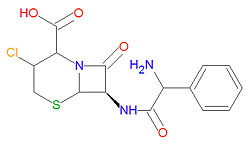Cefaclor: Difference between revisions
imported>David E. Volk No edit summary |
imported>David E. Volk No edit summary |
||
| Line 12: | Line 12: | ||
|molmass= 367.8074 | |molmass= 367.8074 | ||
|uses=antibiotic drug | |uses=antibiotic drug | ||
|properties= | |properties= beta-lactam | ||
|hazards=see drug interactions | |hazards=see drug interactions | ||
|iupac= see chemistry section | |iupac= see chemistry section | ||
| Line 19: | Line 19: | ||
'''Cefaclor''', also spelled as '''cephaclor''', is | '''Cefaclor''', also spelled as '''cephaclor''', is a semisynthetic broad-spectrum [[antibiotic]] drug used to treat a variety of bacterial infections. It is a second generation [[cephalosporin]] antibiotic with similar activities. It is similar in structure to [[cephalexin]] and is also similar to penicillin-like drugs because it contains a [[beta-lactam]] moiety which binds to and interferes with bacterial cell wall synthesis. It can be used to treat a wide variety of both [[Gram-postive]] and [[Gram-negative]] aerobic bacteria. | ||
== Mechanism of action == | |||
Because cefaclor is a beta-lactam-based antibiotic, it binds to specific [[penicillin-binding protein]]s located inside the bacterial cell wall and inhibits the final stage of bacterial cell wall synthesis. As a consequence of the defective cell walls, the bacteria cells are autolysed by [[autolysin]]s, autolytic enzymes. Cell lysis is then mediated by bacterial cell wall autolytic enzymes such as autolysins. | |||
== Susceptible microbes == | |||
Among the Gram-postive bacteria, cefaclor has shown activity against [[Staphylococci]], including coagulase-(±) and penicillinase (+) strains, [[Streptococcus pneumoniae]], and [[Streptococcus pyogenes]]. Among the Gram-negative aerobes, cefaclor is active against [[Escherichia coli]], [[Haemophilus influenzae]], including ß-lactamase-producing ampicillin-resistant strains), [[Klebsiella sp]], and [[Proteus mirabilis]]. | |||
== Chemistry == | == Chemistry == | ||
| Line 25: | Line 31: | ||
== Synonyms and brand names == | == Synonyms and brand names == | ||
{{col-begin}} | {{col-begin}} | ||
{{col-break|width=25%}} | {{col-break|width=25%}} | ||
| Line 48: | Line 52: | ||
* Raniclor | * Raniclor | ||
{{col-end}} | {{col-end}} | ||
== External links == | |||
{{DailyMed}} | |||
{{MedMaster}} | |||
{{DrugBank}} | |||
Revision as of 13:54, 23 April 2008
|
| |||||||
| cefaclor (cephaclor) | |||||||
| |||||||
| Uses: | antibiotic drug | ||||||
| Properties: | beta-lactam | ||||||
| Hazards: | see drug interactions | ||||||
| |||||||
Cefaclor, also spelled as cephaclor, is a semisynthetic broad-spectrum antibiotic drug used to treat a variety of bacterial infections. It is a second generation cephalosporin antibiotic with similar activities. It is similar in structure to cephalexin and is also similar to penicillin-like drugs because it contains a beta-lactam moiety which binds to and interferes with bacterial cell wall synthesis. It can be used to treat a wide variety of both Gram-postive and Gram-negative aerobic bacteria.
Mechanism of action
Because cefaclor is a beta-lactam-based antibiotic, it binds to specific penicillin-binding proteins located inside the bacterial cell wall and inhibits the final stage of bacterial cell wall synthesis. As a consequence of the defective cell walls, the bacteria cells are autolysed by autolysins, autolytic enzymes. Cell lysis is then mediated by bacterial cell wall autolytic enzymes such as autolysins.
Susceptible microbes
Among the Gram-postive bacteria, cefaclor has shown activity against Staphylococci, including coagulase-(±) and penicillinase (+) strains, Streptococcus pneumoniae, and Streptococcus pyogenes. Among the Gram-negative aerobes, cefaclor is active against Escherichia coli, Haemophilus influenzae, including ß-lactamase-producing ampicillin-resistant strains), Klebsiella sp, and Proteus mirabilis.
Chemistry
The IUPAC chemical name for cefaclor is (6R,7R)-7-[(2-amino-2-phenylacetyl)amino]-3-chloro-8-oxo-5-thia-1-azabicyclo[4.2.0]oct-2-ene-2-carboxylic acid, and it has chemical formula C15H14ClN3O4S giving it a molecular mass of 367.8074 g/mol.
Synonyms and brand names
|
Synonyms
|
Brand names
|
External links
Cefaclor - FDA approved drug information (drug label) from DailyMed (U.S. National Library of Medicine). Template:MedMaster Template:DrugBank
